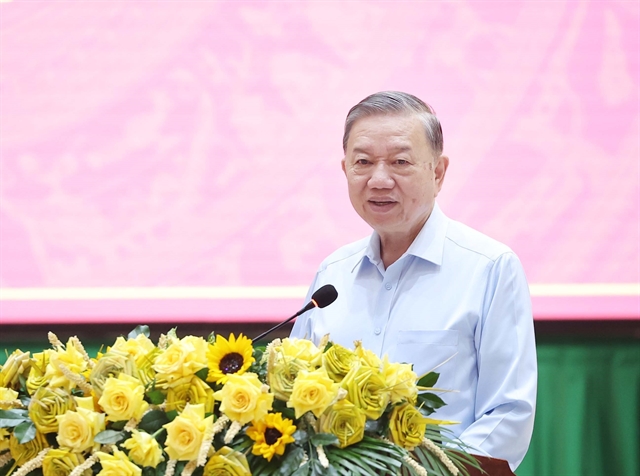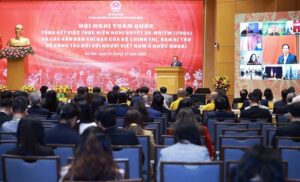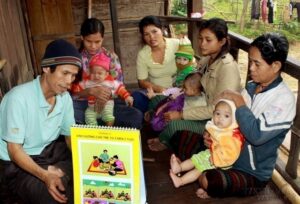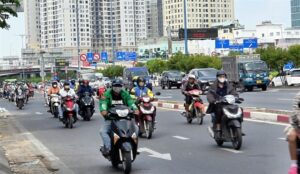Tô Lâm Outlines Strategic Vision for Vĩnh Long Province as Emerging Regional Economic Hub

Hanoi, The Gulf Observer: The newly established Vĩnh Long Province has been identified as possessing all essential conditions to become a regional centre for economic activity, logistics, high-tech agriculture, renewable energy, and marine services, according to Party General Secretary Tô Lâm.
Speaking on Tuesday during a working session in Bến Tre Province with the Standing Committees of the Provincial Party Committees of Bến Tre, Trà Vinh and Vĩnh Long, the Party leader underscored the province’s unique geographic and strategic significance. Positioned between the lower reaches of the Tiền and Hậu Rivers and bordered by the East Sea, Vĩnh Long is set to become a critical bridge connecting inland areas with the sea and international supply chains.
General Secretary Tô Lâm stressed that this strategic location provides a robust foundation for establishing an eco-economic zone and a climate-resilient, modern riverine and coastal urban model aligned with the broader sustainable development vision of the Mekong Delta.
During the session, General Secretary Lâm also highlighted a bold proposal: the merger of Vĩnh Long, Bến Tre, and Trà Vinh into a single administrative-economic unit. This move, he said, would not merely redraw administrative boundaries but would serve as a transformative measure to restructure regional development in a more integrated, synchronised, and efficient manner.
Such a consolidation would enable the combined entity to leverage the comparative advantages of each locality, enhance mutual complementarities, and foster robust economic linkages. The three provinces, he noted, possess naturally complementary economic structures, sectoral strengths, and geographic advantages, forming a strong basis for harmonised and well-rounded development.
Culturally and socially, the provinces share a stable population base and a unified regional identity, creating favourable conditions for institutional integration, harmonised governance, and the preservation of cultural values. These are critical prerequisites for the formation of a competitive, effectively governed regional growth pole at both national and international levels.
“This is an opportunity to shift from a fragmented, province-based development model to a coordinated regional framework with the scale to attract strategic investments, implement interconnected infrastructure projects, drive digital public governance, promote green growth, and respond proactively to climate change,” he said.
He added that such transformation must be accompanied by a modern, agile governance mindset — one that is streamlined, transparent, technologically advanced, and capable of unlocking a new era of dynamic growth in the Mekong Delta.
Strategic Path Forward
In his concluding remarks, General Secretary Tô Lâm commended the recent progress and achievements of the three provinces, affirming that these accomplishments provide a strong foundation for their merger into a high-performing administrative-economic entity and a new growth engine for the region.
Nonetheless, he acknowledged persistent challenges, particularly the fragmented development of key sectors with strong complementarities, such as coconut processing, aquaculture, organic agriculture, and clean energy. He noted a lack of integrated value chains and effective coordination across provincial borders.
He also highlighted uneven socio-economic infrastructure across the region, especially concerning coastal access, inland ports, and waterway-based transport corridors, which remain underdeveloped.
To address these challenges, he directed the Standing Committees of the three provinces to urgently review the progress made under the 2020–2025 Party Congress Resolutions. He urged bold reforms in institutional structures, public communication strategies to build consensus, and the strategic repurposing of underutilised public assets to prioritise cultural, educational, and healthcare needs.
General Secretary Lâm stressed that the proposed merger should mark a pivotal juncture to define a new, bold and sustainable development vision. He called for the new province to be firmly positioned within the Mekong Delta’s development framework, in close alignment with national economic corridors and the Mekong Delta Climate Resilience Development Strategy, as outlined in Resolution No. 13-NQ/TW.
He further instructed a rapid review, adjustment and unification of the master plans of Vĩnh Long, Bến Tre, and Trà Vinh into a cohesive development blueprint, ensuring synergy, avoiding overlaps, and maximising the ecological and economic strengths of each locality.
Looking ahead, the long-term objective is to transform the new province into a competitive growth centre grounded in smart, green, and multi-nodal development, leveraging digital transformation, innovation, and deep international integration.
In closing, General Secretary Lâm called on provincial leaders to adopt a forward-looking vision. “We must move beyond short-term administrative thinking and embrace a long-term strategic approach focused on development facilitation. This requires coordination across Party leadership, government institutions, businesses, and the broader public,” he affirmed.
He also urged the prompt translation of recent Party Central Committee resolutions into actionable plans, with clearly defined goals, responsibilities, implementation timelines, and measurable outcomes — all designed to ensure the successful emergence of a dynamic, unified, and sustainable growth hub in the heart of the Mekong Delta.


